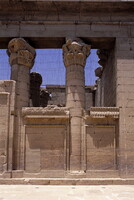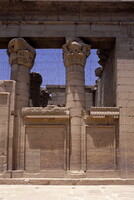| dc.coverage.spatial | Site: New Kalabsha Reconstruction (Aswan, Upper Egypt, Egypt) | en_US |
| dc.coverage.temporal | ca. 30 BCE-450 CE (inclusive) | en_US |
| dc.creator | unknown (Egyptian (ancient)) | en_US |
| dc.date | -30-450 | en_US |
| dc.date.accessioned | 2013-04-17T18:20:58Z | |
| dc.date.available | 2013-04-17T18:20:58Z | |
| dc.date.issued | -30-450 | en_US |
| dc.identifier | 208997 | en_US |
| dc.identifier.other | archrefid: 982 | en_US |
| dc.identifier.uri | http://hdl.handle.net/1721.3/116877 | |
| dc.description | Façade of the Hypostyle Hall, north side, showing inter-columnar walls and columns with bell capitals; The Temple, from Kalabsha, (ancient Talmis), was moved to its present site in 1970. The sandstone edifice was built by the Roman Emperor Octavius Augustus (30 to 14 BCE) and dedicated to the fertility and Nubian Solar deity known as Mandulis (Merwel who was the Nubian counterpart of Horus). It was the largest free-standing temple of Egyptian Nubia and the design of Kalabsha Temple is standard for the Ptolemaic period with pylons, courtyard, hypostyle hall and three room sanctuary. However, the Pylon is offset, which creates a trapezoid in the courtyard beyond. It was built on the site of an earlier structure built by Ptolemy IX as evidenced by a chapel. There is also a small chapel and gate on Elephantine Island from Kalabsha, and a gate built by Augustus was given to the Agyptisches Museum in Berlin. "The inscriptions at Kalabsha show activity into the Bellana period (ca. 360-550 CE). A graffito of the mid-5th century CE in the temple of Kalabsha shows King Silko triumphing over the Blemmyes (a people of the Eastern Desert) and in the act of being given the Meroitic plumed atef-crown by a Roman winged Victory." Source: Grove Art Online; http://www.groveart.com/ (accessed 1/18/2008) | en_US |
| dc.format.medium | stone; limestone | en_US |
| dc.rights | © Scott Gilchrist, Archivision, Inc. | en_US |
| dc.subject | architectural exteriors | en_US |
| dc.subject | rulers and leaders | en_US |
| dc.subject | Roman Empire | en_US |
| dc.subject | Ptolemaic | en_US |
| dc.subject | Imperial (Roman) | en_US |
| dc.title | Temple of Kalabsha | en_US |
| dc.type | image | en_US |
| dc.rights.access | Licensed for educational and research use by the MIT community only | en_US |
| dc.identifier.vendorcode | 1A3-EG-K-2-B10 | en_US |
| vra.culturalContext | Egyptian (ancient) | en_US |
| vra.technique | carving (processes) construction (assembling) | en_US |
| vra.worktype | excavation (site) | en_US |
| vra.worktype | temple | en_US |
| dc.contributor.display | unknown (Egyptian (ancient)) | en_US |


